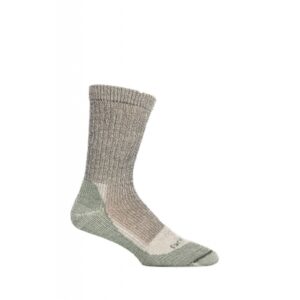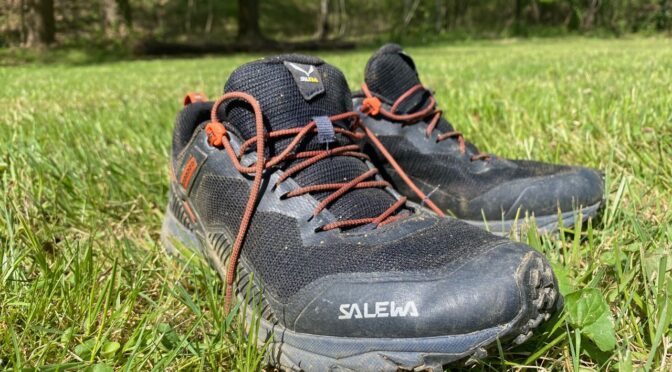Wednesday Wisdom? That may be a stretch (though it is alliterative). Every Wednesday we share our thoughts in rotating subject areas: gear, social media, hiking/backpacking/camping resources, and tips from the field. These items are culled from our weekly GetHiking! enewsletter, which also includes news and information on hikes and backpack trips in our GetHiking! and GetBackpacking! universes. Subscribe to our weekly enewsletter here.
This week’s focus: Gear, including a shoe and socks
Salewa Ultra Train 3 ‘speed hiking’ shoe
I’m protective of my feet: without their support I not only miss out on my favorite recreation, I’m deprived of a living as a hiking and backpacking guide. So when I’m approached by a shoe manufacturer about test-driving one of their fleet, I’m a bit apprehensive: when you hike about 40 miles a week you can’t afford for them to be unhappy. It helps, though, if you’ve had good experiences with the manufacturer’s line. Such is the case with Salewa, which sent me a pair of Ultra Train 3s a couple months back.
I’ve hiked in Salewas, off and on, for about a decade. I’ve been particularly happy with the Ultra Train line, though I’m not a fan of the elastic lacing used in the Ultra Train 2. Fortunately, that system has been replaced in the UT3 by traditional laces, which offer more flexibility in securing a snug fit.
The UT3 is categorized as being for “speed hiking,” a cross, I suppose, between a traditional hiking shoe and a train running shoe. I can see that: the shoe is light (357 grams, or about 12.6 ounces per shoe) and appears spare at first glance. Which brings me to the first thing I love about this shoe:
- No sore feet. On a hike of more than 10 miles or on a backpack trip, the first thing to go for me are my feet. Often, my soles start getting tender after a couple hours of hiking. Not so with the Salewa Ultra Train series. I’ve put more than 300 miles on my UT3s in two months, and I don’t recall a time when my feet cried uncle before the rest of my body did. (And it’s not that my feet are suddenly less tender; I’ve hiked in other shoes and boots during this time and have experienced soreness.) Even with 28 pounds or so on my back, no soreness, bringing me to my second favorite thing about the UT3 …
- Good for backpacking. I’ve done a couple of backpack trips in the UT3s and have been surprised by how they’ve handled the load. I’m neither an ultra-lighter nor someone who brings multiple changes of clothes depending upon my mood: again, my full pack weight is typically 26, 28 pounds. The shoes … well, to quote the Salewa web site, “The sole and midsole work together with Motion Guidance technology to support natural movement and ensure stability over any terrain.” Not exactly sure what that means from a tech standpoint, but it does handle the load and does so with another thing I love about the shoe…
- Stability and grip. Again, I’m not good with interpreting the UT3’s specs, but the shoe’s innards to a good job of providing stability, and the soul has a grip you wouldn’t assume by looking at it. On the morning I’m writing this, my buddy Will and I took an early morning along the Eno River. We came to an unbridged drainage that had steep and muddy banks; I made judicious use of my trekking poles for balance, but the shoes did a much-appreciated job of grabbing onto the slippery slope. Likewise, this past weekend hiking in the Wilson Creek area of the Pisgah National Forest, an area with lots of rock and water, I was further challenged by intermittent rain. The soles — again, with more than 300 miles on them — were faultless on rain-slicked rock and mud.
The Altra Lone Peak is generally considered the top lightweight hiking shoe, especially by thru-hikers (the Appalachian Trail, the Pacific Crest Trail, et al). I’ve had three pairs of Lone Peaks and can see why. With the Salewa Ultra Train 3 you get many of the Lone Peak’s attributes, but in a shoe that’s more stable and, based on my experience, more durable. An especially good shoe choice as we head into prime hiking season and you start logging more miles.
Learn more about the Salewa Ultra Train 3 here.
Warm weather socks
We’re coming up on our first 80-degree hiking days of the season — and the beginning of the mysterious “sweaty foot season.” Why, we wonder, are our feet suddenly hot and sweaty during a hike? I mean, I haven’t changed a thing, and yet … . And yet that’s the problem — you need to change a thing, that thing being your socks. Those wool socks you’ve been sporting all winter, the ones that have kept your feet nice and toasty? They may be too much for warm weather hiking. Most hiking sock makers make socks for a variety of conditions; often, you can tell their suitability for warm weather hiking based on their cushioning. Socks with medium and heavy cushioning will make your feet sweat; switch to a lightly cushioned sock and to either an ankle-length or crew sock: come summer, cool feet are happy feet. For more on what makes a good summer hiking sock, check out this post from BestHiking.net, which also makes five sock recommendations.
Farm to Feet No Fly Zone socks

As soon as it warms up, which it finally is, hikers want to know: What about ticks? Well, they’re out there. And we advocate fending them off starting from the ground up. As in, with Farm to Feet’s No Fly Zone hiking socks treated with permethrin. Permethrin wards off common biting insects such as mosquitoes, flies, chiggers, midges, ants and, yes, even ticks. Plus, Farm to Feet socks are not only made in the USA, the company is based in Mount Airy! And, the socks are 100 percent merino wool. Check ‘em out here.
Convertible pants

We’re in that time of year when it can be cold when we start down the trail, hot by the time we return (or vice versa). That makes it an ideal time for convertible pants, a k a zip-offs. Pants that can go both ways: in the early morning chill, they’re pants, providing full-leg protection and warmth. Then, when things start to heat up, you zip off the legs and — viola! — shorts! We won’t recommend a specific make or brand, but we do suggest that you get the kind with a side zipper up the side of the calf, making for speedy ons and offs without having to take off your boots. Also, make sure they’re made of a quick-drying material. If you need a little direction in selecting a pair, check out SectionHiker.com‘s list of “10 Best Hiking Pants,” which includes four convertibles (including the best bargain of the bunch, the Columbia Silver Ridge Convertible).
